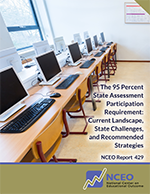NCEO recently published The 95 Percent State Assessment Participation Requirement: Current Landscape, State Challenges, and Recommended Strategies (NCEO Report #429). This report provides an overview of federal statutory language on student participation in state summative assessments used for accountability as well as the participation requirements for states requesting waivers from the 1% threshold on participation in the alternate assessment based on alternate academic achievement standards (AA-AAAS). It also includes a review of why it is important that students participate in testing, the reasons why some states have found it challenging to meet the 95% participation rate, and the extent to which states have met federal testing participation requirements.
Addressing stakeholder questions and clarifying the value of testing can encourage student participation in state assessments. Communication tools and the development of a communication plan can support states in communicating testing purpose and importance clearly as well as addressing stakeholder questions and concerns about testing. The report includes examples of strategies several states used to address assessment participation. To support districts and schools, states might consider:
- What messages do our districts and schools receive about our state’s testing system? How consistent is this messaging across stakeholders? How do our communication tools address different stakeholders’ understandings of our testing system?
- How do our communication tools explain accessibility features and accommodations available to support all students participating in assessments?
- How transparent are our communication tools about state testing and how assessment data are used?
- How do we support our districts and schools in analyzing data to identify challenges reaching the 95 percent participation rate requirement?
- How do our state’s contingency plans help districts and schools in cases where technology or equipment challenges impact assessment administration?
- How can our state’s supports be used in different school contexts (e.g., in-person instruction, remote instruction, hybrid instruction)? Are our supports adaptable to different school contexts?

